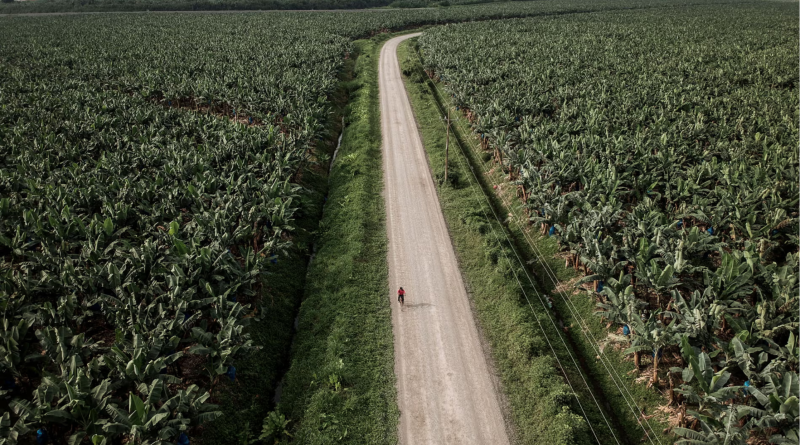‘Every time the planes pass, my eyes burn’: the hidden cost of Costa Rican bananas

For more than 20 years, Lidieth Gomez’s days have been punctuated by the hum of crop-spraying planes. At dawn and dusk, the skies over Matina, capital of Limón province on Costa Rica’s Caribbean coast, are filled with aircraft spraying a viscous rain of agrochemicals on to banana plantations.
The endless green sea of banana fields surrounding Gomez’s spartan wooden home belongs to Limofrut, part of Grupo Acón, one of the main players in Costa Rica’s banana and pineapple export industry.
Gomez, a single mother of three, is one of 451 women participating in research by the Regional Institute for Studies of Toxic Substances (IRET) at the National University of Costa Rica. For 14 years, this study on pesticide exposure has investigated how chemicals used on banana plantations affect thyroid health and foetal development in pregnant women.
“Every time the planes pass by, my eyes start to burn and my arms itch,” says Gomez. Other common symptoms from coming into contact with pesticides include nausea, vomiting, dizziness, fainting, dermatitis and burning eyes.
Among the pesticides found in the blood of women and children, including Gomez, 51, and her son Daniel, 14, are chlorothalonil and mancozeb – two fungicides associated with potential carcinogenic effects – as well as chlorpyrifos, known for its neurotoxic effects on children, and neonicotinoids, a type of insecticide which can hinder neurological development.
Many of these agrochemicals are banned in Europe but continue to be produced and exported to countries such as Costa Rica, where they help to meet market demands for the kind of aesthetically perfect bananas sold worldwide.
With more than 83,000 hectares of land cultivated with bananas and pineapples, Costa Rica is the world’s third-largest banana exporter and leading pineapple producer. In 2023, it produced approximately 2m tonnes of bananas and 2.5m tonnes of pineapples, primarily for export to the US and Europe.
Between 2000 and 2015, the country’s pineapple production increased by 700%, contributing to the destruction of more than 5,000 hectares (12,400 acres) of forest and leading to severe pesticide-related health issues in local communities.
Costa Rica ranks among the leading countries in the world for pesticide use, reported to be as high as 34.45kg for each hectare every year, according to a 2022 UNDP study.
Such intensive use of chemicals helps to maximise yields and produce defect-free fruit, but the effects of this production model fall squarely on local people and the environment. On 23 June 2023, pupils and staff at the IDA La Victoria elementary school in Santa Rita de Río Cuarto began to notice a nauseating chemical smell.
“It was terrible. We evacuated the children, but the air outside was worse than inside. Almost all the children started hyperventilating within minutes,” says the headteacher, Rosalyn Sibaja Gomez.
In August, the same school experienced a similar event, resulting in 38 children and teachers being taken to hospital over the two incidents.
Documents from IRET and documents from the health ministry seen by the Guardian reveal that many of the agrochemicals found at the school – including ametryn, diazinon, chlorpyrifos, oxyfluorfen, terbufos and cadusafos – are banned in Europe.
Agroindustrial RyB, the spraying company, was approached for comment several times but did not respond.
The Santa Rita de Río Cuarto incident is far from exceptional. Several other schools in the region have also experienced severe pesticide-related incidents.
Near Alfredo Miranda García school, the air is pungent, fields are scorched and the ground is strewn with what looks like the remnants of charred pineapples. The plantation, Agroindustrial Piñas del Bosque – Finca La Virgen, spans 600 hectares and belongs to the US multinational Dole, the world’s biggest fresh produce company.
“They use paraquat to dry and burn the plants, so it’s faster,” says Héctor Dávila, a worker in the pineapple fields and a member of the National Union of Agricultural Workers (Sintraac).
Exasperated, local people gathered testimony, photos and videos indicating the frequent use of paraquat. “They always do it in the afternoon or at night. The smell is unbearable the next day,” says Mariza García Miranza, headteacher of the elementary school.
“We have reported the issue to local authorities multiple times, but we are David against Goliath,” she says.
Maciot Robles Padilla, 41, a mother of three children who lives near the school, says her family are constantly sick. “We are all ill with asthma, coughs and allergies.
“They see us as a resource to be exploited,” she says. “What is the benefit for the community? None. What remains here is destruction and ill people.”
At dawn in Dole’s Finca Banadosmil Dos, workers spread a mix of herbicides around the banana rhizomes while a crop-dusting plane releases a sticky mist from above. Other workers, mostly Nicaraguans, move swiftly from tree to tree, covering banana bunches with blue plastic bags they say are soaked in chlorpyrifos and other insecticides.
“We are always exposed to the poison while working. I wrote a complaint to the company but it was useless,” says Gérman Jimenez, 51, who is paid 18,000 colones (about £25) a day to apply herbicide from 4.30am to 11.30am. He lives with his four children on the plantation in a wood and metal hut with no drinking water or electricity.
The Agricultural Plantation Workers Union (Sitrap) is well aware of the effects of pesticides on its 2,500 members. For years, Didier Leiton Valverde, its general secretary, worked on plantations of United Fruit (now Chiquita International) using Nemagon, a highly toxic pesticide linked to severe health problems such as infertility.
“We do not want fruit multinationals to stop buying bananas from Costa Rica,” he says, but adds: “We demand respect for workers’ human rights.”
Dole denied the paraquat allegations and said: “La Virgen is an organic farm that does not use synthetic chemicals.” It added: “Dole stopped using paraquat in all its pineapple farms in February 2008.”
Between 2019 and 2021, the EU banned several pesticides from agricultural use in member states due to their potential carcinogenicity, endocrine-disrupting properties, possible brain damage to children and foetuses, and their effects on ecosystems and aquatic organisms.
However, a document from the Costa Rican agriculture ministrydata from the Costa Rican State Phytosanitary Service for 202 shows that products banned in Europe, including chlorpyrifos (exported from Belgium), mancozeb (exported from Italy), and diazinon (exported from Spain via China) are still largely used on farms in the Central American country.
The export of hazardous substances and pesticides is regulated globally by the Rotterdam Convention, which allows countries to decide whether to import them, while the EU’s prior informed consent regulation governs these exports to non-EU countries or imports to the EU.
Adalbert Jahnz, a spokesperson for the European Commission on the environment, says: “A ban of exports from the EU does not automatically mean that third countries stop using such pesticides … Convincing these countries not to use such pesticides therefore remains crucial.”
Fernando Ramirez Muñoz, a researcher at IRET, sees European practices of not preventing the export of banned pesticides as “chemical colonialism”.
“It is not fair that in poorer countries, the health of most people, aquatic ecosystems, micro-organisms and soils is compromised to allow a few to continue their business,” he says.
As Laurent Gaberell, a food and agriculture expert at the Swiss rights organisation Public Eye, says: “Even if there were an export ban from the EU, the supply chain remains complex and controlled by a few large multinationals.
“A broader systematic approach is needed,” he says. “These chemical products are persistent, remaining in water and soil for decades, contaminating everything.”
or Berendina van Wendel de Joode, an environmental epidemiologist at IRET, there are clear double standards. As far as the agro-industrial system is concerned, she says: “Children and, more generally, citizens of Costa Rica, do not hold the same value as their European counterparts.”
While no barriers are imposed on the production, export or import of these products in Costa Rica, some are embracing organic farming practices that honour plant biodiversity rooted in the ancestral traditions of Indigenous communities.
Marina López is a member of the Bribri community and lives in Uatsi, about six miles from Puerto Viejo de Talamanca, the gateway for Spanish colonisers and the port from which bananas and other fruit have been shipped to Europe and the US for centuries.
On her farm, amid a lush forest, López grows bananas, coffee, cacao and other products, which she sells through fair trade outlets or directly to small groups of tourists, whom she and her son guide through the forest to learn about medicinal plants.
“Everything here is organic. Our ancestors never worked with agrochemicals, and I have chosen not to do so either. I could have produced more, but that would have meant killing other forms of life,” she says.
“The blue plastic bags full of pesticides used in intensive plantations end up in the rivers and soil and in our food. I don’t believe this is development. True development is protecting biodiversity.”
-
Additional reporting by Darío Chinchilla
-
The Journalismfund Europe supported this investigation





